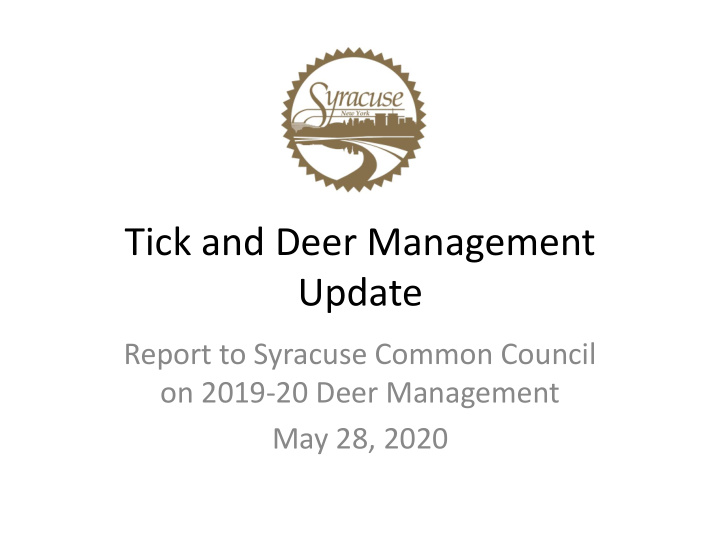



Tick and Deer Management Update Report to Syracuse Common Council on 2019-20 Deer Management May 28, 2020
Background • The City of Syracuse and other municipalities have experienced the growing overpopulation of deer. • Mayor Walsh appointed a Tick and Deer Management Advisory Group in 2019 to make recommendations to the City. • In response to public health and safety concerns, the City began a deer damage management program in certain parts of the City last winter.
Purpose • The purpose of the program is to address the impact of the overpopulation of white-tailed deer: – deer-vehicle accidents – parks, gardens, and the ecosystem – public health risks, such as Lyme Disease • Part of an integrated program that also includes public education
Description • Sites meeting strict New York State Department of Environmental Conservation (NYSDEC) criteria were identified on the east, west and south sides of the City. – large private and city-owned properties and are closed to public access when work is conducted – explicit written permission from the property owners has been provided will be used – at least 500 feet from any occupied dwelling. • The program is funded by Onondaga County and approved by New York State DEC.
Description (cont.) • The work was done by qualified United States Department of Agriculture (USDA) wildlife managers. • The program was conducted in coordination with the Syracuse Police Department. • City issued public notice of program. • Wildlife managers worked at night.
Results • During the months of December, January, February and March, NE: na over a 20 night period: NW: 33 – 159 white-tailed deer SE: 79 were removed (average of 8 deer/night) SW: 47 – After processing, 4,062 pounds of venison were delivered for donation – Provided 16,248 meals to the local community
Results (cont.) • Some intentional and unintentional interference with baiting activities at several locations. • Project completed within authorized budget • Eight tick borne illness prevention public education meetings; 308 participants
USDA Recommendations • Identify additional properties be added to the program to increase the overall coverage • In areas where deer densities are high and shooting is not a feasible option, consider live trapping or other options to increase effectiveness • Track deer damage data
Next Steps • Reconvene Tick and Deer Management Advisory Group • Conduct additional public outreach – Public input – Tick borne illness prevention • Implement tracking steps (tick density, deer damage, public education) • Update Tick and Deer Management Action Plan to ensure continued safety and effectiveness – Review with Council in late summer/early fall – Maintain program in 2020-21
Results • During the months of December, January, February and March, NE: na over a 20 night period: NW: 33 – 159 white-tailed deer SE: 79 were removed (average of 8 deer/night) SW: 47 – After processing, 4,062 pounds of venison were delivered for donation – Provided 16,248 meals to the local community
Recommend
More recommend